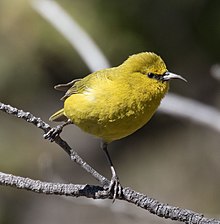Hawaiʻi ʻamakihi
| Hawaiʻi ʻamakihi | |
|---|---|

| |
| Hawaiʻi ʻamakihi on Hawaii | |
| Scientific classification | |
| Domain: | Eukaryota |
| Kingdom: | Animalia |
| Phylum: | Chordata |
| Class: | Aves |
| Order: | Passeriformes |
| Family: | Fringillidae |
| Subfamily: | Carduelinae |
| Genus: | Chlorodrepanis |
| Species: | C. virens
|
| Binomial name | |
| Chlorodrepanis virens (Gmelin, JF, 1788)
| |

| |
| Black: Extinct Green: Current range | |
| Synonyms | |
|
Hemignathus virens | |
The Hawaiʻi ʻamakihi (Chlorodrepanis virens), also known as the common ʻamakihi, is a species of Hawaiian honeycreeper.
Taxonomy
The Hawaiʻi ʻamakihi was formerly placed in the genus
There are two recognized subspecies: C. v. wilsoni on Maui, Molokaʻi, and (formerly) Lānaʻi, and C. v. virens on the Big Island of Hawaiʻi.[3]
Description
The Hawaiʻi ʻamakihi is a small bird, measuring about 10 centimetres (3.9 in) in length.[4] It is yellow-green with a small black bill that is 1.3 centimetres (0.51 in) long and has brown eyes with black pupils.

Song
The primary song of the Hawaiʻi ʻamakihi is a rapid trill. [5]
Diet
The Hawaiʻi ʻamakihi has a very wide diet, and has been able to find food despite habitat alteration. It has a tubular tongue, which it uses to drink
Breeding
Hawaiʻi ʻamakihi are a productive species with a long breeding season, lasting about 9 months. On the Big Island, Maui and Molokaʻi there is variation in when that breeding season starts but it may coincide with flowering of māmane in dry māmane forests. [5] Hawaiʻi ʻamakihi nest in the canopy of trees. They often are able to have two broods within a breeding season; having two rounds of chicks enables their population to increase more rapidly than slow growing species like the endangered Kiwikiu. Chicks remain in the nest for 15-21 days before they fledge. [5] Young Hawaiʻi ʻamakihi become independent from their parents at 2-3 months. [5]
Habitat and distribution
It is found on the
References
- . Retrieved 12 November 2021.
- PMID 22018543.
- ^ a b Gill, Frank; Donsker, David (eds.). "Finches, euphonias". World Bird List Version 5.2. International Ornithologists' Union. Retrieved 5 June 2015.
- ^ a b "Hemignathus virens". Native Forest Birds of Hawai'i. Conservation Hawaii. Archived from the original on 2010-04-27. Retrieved 2009-02-07.
- ^ .
- ^ a b Hawaii Amakihi Archived 2012-05-23 at the Wayback Machine, Hawaii's Comprehensive Wildlife Conservation Strategy. Accessed 18 May 2012.
External links
- Images - Monte M. Taylor
- Videos, photos and sounds - Internet Bird Collection

